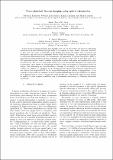Files in this item
Nonredundant Raman imaging using optical eigenmodes
Item metadata
| dc.contributor.author | Kosmeier, Sebastian | |
| dc.contributor.author | Zolotovskaya, Svetlana | |
| dc.contributor.author | De Luca, Anna Chiara | |
| dc.contributor.author | Riches, Andrew C | |
| dc.contributor.author | Herrington, C Simon | |
| dc.contributor.author | Dholakia, Kishan | |
| dc.contributor.author | Mazilu, Michael | |
| dc.date.accessioned | 2015-03-27T16:31:05Z | |
| dc.date.available | 2015-03-27T16:31:05Z | |
| dc.date.issued | 2014-10-20 | |
| dc.identifier | 163898288 | |
| dc.identifier | 5cfaa00b-e019-455d-8695-c43174f1d966 | |
| dc.identifier | 84935507354 | |
| dc.identifier | 000354863900010 | |
| dc.identifier.citation | Kosmeier , S , Zolotovskaya , S , De Luca , A C , Riches , A C , Herrington , C S , Dholakia , K & Mazilu , M 2014 , ' Nonredundant Raman imaging using optical eigenmodes ' , Optica , vol. 1 , no. 4 , pp. 257-263 . https://doi.org/10.1364/OPTICA.1.000257 | en |
| dc.identifier.issn | 2334-2536 | |
| dc.identifier.other | RIS: urn:9B688D4056BA182C4D51797260823475 | |
| dc.identifier.uri | https://hdl.handle.net/10023/6394 | |
| dc.description | We thank funding from the UK Engineering and Physical Sciences Research Council namely grant EP/J01771X/1 and EU FP7 grant FAMOS. | en |
| dc.description.abstract | Various forms of imaging schemes have emerged over the last decade that are based on correlating variations in incident illuminating light fields to the outputs of single “bucket” detectors. However, to date, the role of the orthogonality of the illumination fields has largely been overlooked, and, furthermore, the field has not progressed beyond bright field imaging. By exploiting the concept of orthogonal illuminating fields, we demonstrate the application of optical eigenmodes (OEis) to wide-field, scan-free spontaneous Raman imaging, which is notoriously slow in wide-field mode. The OEi approach enables a form of indirect imaging that exploits both phase and amplitude in image reconstruction. The use of orthogonality enables us to nonredundantly illuminate the sample and, in particular, use a subset of illuminating modes to obtain the majority of information from the sample, thus minimizing any photobleaching or damage of the sample. The crucial incorporation of phase, in addition to amplitude, in the imaging process significantly reduces background noise and results in an improved signal-to-noise ratio for the image while reducing the number of illuminations. As an example we can reconstruct images of a surface-enhanced Raman spectroscopy sample with approximately an order of magnitude fewer acquisitions. This generic approach may readily be applied to other imaging modalities such as fluorescence microscopy or nonlinear vibrational microscopy. | |
| dc.format.extent | 7 | |
| dc.format.extent | 4559931 | |
| dc.language.iso | eng | |
| dc.relation.ispartof | Optica | en |
| dc.subject | QC Physics | en |
| dc.subject | BDC | en |
| dc.subject | R2C | en |
| dc.subject.lcc | QC | en |
| dc.title | Nonredundant Raman imaging using optical eigenmodes | en |
| dc.type | Journal article | en |
| dc.contributor.sponsor | European Commission | en |
| dc.contributor.sponsor | EPSRC | en |
| dc.contributor.institution | University of St Andrews. School of Physics and Astronomy | en |
| dc.contributor.institution | University of St Andrews. School of Medicine | en |
| dc.contributor.institution | University of St Andrews. Biomedical Sciences Research Complex | en |
| dc.identifier.doi | https://doi.org/10.1364/OPTICA.1.000257 | |
| dc.description.status | Peer reviewed | en |
| dc.identifier.grantnumber | 317744 | en |
| dc.identifier.grantnumber | EP/J01771X/1 | en |
This item appears in the following Collection(s)
Items in the St Andrews Research Repository are protected by copyright, with all rights reserved, unless otherwise indicated.

